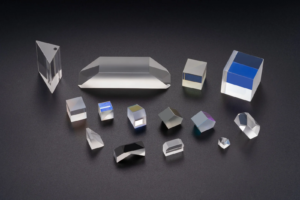Light plays an essential role in how we see and interact with the world—both naturally and through advanced technologies. One simple yet powerful tool for controlling light is the prism. Whether you’re working with cameras, VR headsets, lasers, or lab instruments, prisms help guide and manipulate light precisely. In this blog, we’ll explain what a prism is, how it works, and where it’s commonly used.
Understanding this small glass component can help improve the performance of many optical systems.

What Is a Prism?
A prism is a solid piece of transparent optical material—usually glass or quartz—shaped with flat, polished surfaces. These surfaces are angled so that when light enters the prism, it bends (refracts) or reflects depending on the angle and material.
One of the most popular shapes is the triangular prism, which is often used to split white light into a rainbow (a process called dispersion). But prisms come in many forms like right-angle prisms, penta prisms, and beam-splitting prisms, each with specific functions.
How Does a Prism Work?
When light enters a prism, it changes direction due to a difference in optical density between air and the prism material. This effect is called refraction. In some cases, depending on the angle, light can also reflect off the internal surfaces—this is called total internal reflection.
Prisms can be designed to:
Change the direction of a light beam
Split light into its spectral colors
Rotate or flip an image
Combine or split laser beams
Because of these functions, prisms are essential tools in many light-based technologies.
Key Uses of Prisms in Real-World Applications
You might not see them, but prisms are working behind the scenes in many devices you use or encounter daily:
1. Cameras and Binoculars
Prisms help correct image orientation and guide light to the sensor or viewer’s eye.
2. AR/VR Headsets
Used to direct and reflect images clearly into the user’s field of vision.
3. Laser Systems
Direct and split laser beams in tools, medical devices, or industrial systems.
4. Scientific Instruments
Separate light for spectroscopy or control beam paths in microscopes and lab tools.
5. Telecommunications and Sensors
Used in fiber optic systems and sensors to manage light paths efficiently.
Prisms allow light to be handled precisely, making them a valuable component in any device that relies on optics.
Prism vs. Lens – What’s the Difference?
While both prisms and lenses are used to control light, they do it in different ways. A lens bends light by using curves to focus or spread it. A prism, on the other hand, uses flat surfaces and angles to reflect or redirect light without focusing it.
In many systems, lenses and prisms work together—lenses focus the light, while prisms guide it to the right path or orientation.
Why Choose AR/VR Optical’s Prism?
If you’re looking for precision-crafted optical components, AR/VR Optical provides high-quality prisms for a variety of applications. Their offerings are:
🔧 Manufactured with tight tolerances for clear and accurate light control
🧪 Available in different shapes and materials for custom setups
🌐 Used in AR/VR, laser, imaging, and scientific devices worldwide
🛡️ Durable and designed for both industrial and lab-grade applications
Whether you’re designing a new product or upgrading your optical system, their prisms deliver both performance and reliability.
Final Thoughts
A prism may look like a simple piece of glass, but it plays a critical role in shaping and controlling light in many technologies we rely on. From VR headsets to laboratory tools, prisms help guide light where it needs to go—clearly and efficiently.
If you’re building or upgrading an optical system, choosing the right prism is a smart step toward achieving sharper, more accurate results.